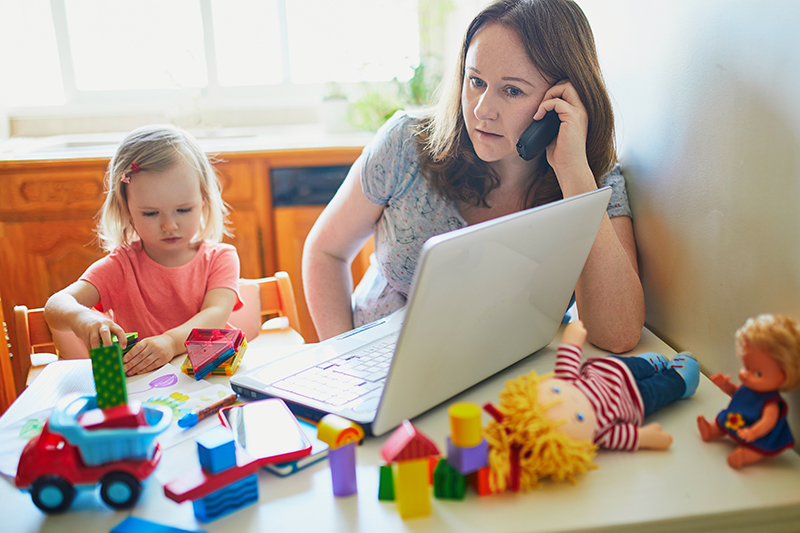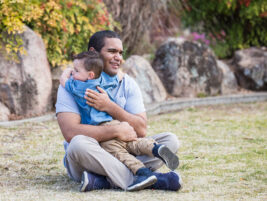Infant Mental Health in practice has had to shift in order to meet the needs of families during the COVID-19 pandemic. I work in a large metropolitan city where there were early cases and concerns over the COVID-19 virus, and where the city had strict stay at home orders in place for several months.
As part of the department of psychiatry in a children’s hospital (that is part of an academic medical center), parents, infants, and children are typically seen in a clinic with an in-person encounter where rapport and relationships are easily formed to provide the basis of a trusting working relationship. This suddenly was not possible as of March 2020 and still largely continues to this day, as the overwhelming majority of outpatient encounters are virtual.
Adapting from in-clinic to telemedicine
Since the COVID-19 pandemic began, I have had to change the mode of service delivery and relationship building, to one via a video screen where I am connected to a family’s home from my home. This is a modality with which I, and my clients, had very little prior experience.
There was a steep learning curve with the technology itself and learning the pragmatics of telemedicine. There were many times when screens would freeze mid-sentence, sessions would get inexplicably disconnected, or families had other difficulties with the telemedicine software. I learned to have the family’s telephone number available in case there were any technical difficulties and to expect the unexpected.
The other important lesson was to be flexible. I may not be able to get all my questions answered, as doorbells rang, and daily home life interrupted (at the client’s home and my own home).
After some trial and error, I established a system of general assessment that seemed to work:
1. I had an initial session with parent(s) to learn their concerns and the child’s history.
2. Then, I had a second session where I observed the infant/child play at home as they typically would. Sometimes this 50-minute play session felt long but allowing it that length of time ended up providing rich information.
3. Then, for preschool-aged children, I would begin the third session with a 15-minute tea party with me and the child. The child could tailor this tea party to their likes (such as a race car tea party or a unicorn tea party).
4. Then provide assessment impressions to the parent at the end of this session.
I found this assessment method via telemedicine gave me a thorough understanding of the child with their family and also helped to establish rapport with the parents and the child/children, in an otherwise awkward modality.
By the time intervention began, the parents and the child seemed more at ease with the video communication and me, and our treatment could begin. I had a few months of adjustment to the video platform when I met Sonja (pseudonym) and her family.
Meet Sonja (4 years old) and her parents
Sonja’s mother and father sought an evaluation for their 4-year-old daughter due to concerns of limited engagement in her daycare setting. She would alternate between periods of not responding to and being withdrawn from her teachers to being upset and frustrated very quickly. Sonja generally interacted well with peers at daycare but tended to want to control the play and would become upset if peers did not comply. She also wanted to be in charge of how her parents played with her at home by telling them what to do, what to say, and in what tone of voice to speak. She would become quite upset if her parents did not comply with her wishes and demands. She could be particular and would only watch TV shows, not movies, and only certain episodes of TV shows. If an unfavored episode came on the TV she would cover her ears and come to parents shaking.
Sonja was described as very-creative and engaged in elaborate imaginary play quite often. Sonja’s parents recounted a time when she created a family band to perform in front of an audience of her stuffed animals. When it came time for the performance, Sonja seemed to get stage fright in front of the stuffed animals and wrecked the entire set-up, and dismantled the band. She was very articulate and could express her feelings well, so her parents were puzzled as to the extreme frustration and upset she would display at home.
Sonja’s mother and father indicated that they both had histories of anxiety and still struggled somewhat with symptoms themselves. They recounted stories and incidents from their childhoods that reminded them of Sonja’s behavior and wondered whether Sonja had anxiety too? They questioned whether the way they intervened and parented Sonja could be exacerbating her symptoms.
As COVID-19 began, it necessitated that Sonja would need to attend her daycare via a video screen. It became commonplace in our area for preschools to offer the remainder of the school year virtually. At this time, her parents saw a change in her. Sonja was able to connect to her classmates and teacher via a video platform while she was in the comfort of her home with her younger sister and her parents (who, by this time, were working from home via a video platform themselves). She attended this style of virtual preschool from March 2020 until the summer break began at the end of May 2020. When connected with her teachers and peers via the video, she was animated, engaged, and seemed to be enjoying herself very much.
Her teachers and parents both noted the change in her demeanor. Sonja was suddenly talkative, adding to discussions in the virtual classroom, and asking meaningful questions. She would laugh with her classmates and appeared to be at ease in the environment. This was in contrast to her flat affect and reluctance to speak when attending school in-person.
However, one of her parents had a compromised immune system so the family was not going outside of the home much or connecting with others. Her parents worried about how staying in the home so much during the pandemic would affect Sonja’s social abilities and her eventual adjustment back to daycare (now that Sonja had not been connected to daycare for the past several months of summer).
Initial concerns about the usefulness of telemedicine
Her parents also questioned whether telemedicine was feasible with their family and wondered whether they and Sonja could feel connected to a clinician when our interactions were through a video screen.
I too wondered how helpful telemedicine could be for Sonja and her family. Her parents appeared quite anxious about the process, in general, and even more anxious about treatment through a video screen.
I questioned whether I would be able to support the parents and deliver a service to them in a way that could improve symptoms when I could not be physically present with them.
I also wondered how effective my assessment had been of Sonja and worried a bit that I might have missed a key element simply because I could not be present with them.
But, with limited options, the family agreed to try telemedicine to see if symptoms could further improve for Sonja.
Getting started with Sonja and her family via telemedicine
I had to put my reservations aside because the primary focus quickly became Sonja’s adjustment to a new school, as decisions had to be made soon. Through the pandemic, the daycare where Sonja had attended full-time since the age of 9 months, first, lost its teachers and then, eventually closed. Her parents felt strongly that Sonja needed to attend school and be in the company of peers to advance her social skills. And they scrambled to find a suitable option for her. Through the recommendation of friends, they decided to enroll Sonja in a particular preschool, five mornings per week but worried about Sonja’s ability to adjust to all the change.
Preparing for the video-sessions
I tried to prepare for telemedicine sessions with Sonja, not really knowing what to expect.
I wondered whether Sonja would be reluctant to engage. Would she display negative behavior? How might the parents respond to this and how would we proceed?
I felt that her parents might appreciate a structure to our sessions so they would know what to expect, could prepare themselves and Sonja, and therapy might be more fruitful.
I decided to start our sessions with a greeting to all family members and a check-in with the parents about how things had been going since our prior session. I had then planned to address Sonja directly and attend to what she happened to be doing at the moment and then ease into a discussion with the family about specific issues and strategies.
I prepared for this plan not to work by having a few stuffed animals and figures nearby with which to distract and/or engage Sonja if needed.
I just needed to begin the sessions and see how Sonja reacted while preparing an alternate plan. The planning turned out to be unnecessary.
Telemedicine video sessions with Sonja and her parents
In working with the family, Sonja would look forward to our video sessions. She would have toys set up with which to play and have topics ready to address with the clinician. During one of our first sessions, Sonja stopped playing and asked me directly if she could discuss something with me. She then went on to very articulately express her frustration with her younger sibling and describe how she had “mixed feelings” about loving her sibling and being annoyed by her sibling.
She was also very expressive with her parents during sessions and easily expressed her feelings and explanations for her behavior. It was quite remarkable to observe how articulate and engaged she was, and she continued to be a very active participant in our sessions.
Concerning school, Sonja explained that she was both nervous and excited to start a new school. She was to meet her teacher weeks before school in a park and her entire family was invited to this meeting. Sonja was feeling “scared” about this meeting and wasn’t sure she wanted to attend. Her parents worried that the meeting in the park would not go well and then it may be very difficult to get Sonja to attend school.
Because she had been so engaged via video with her daycare and in her sessions with me, we explored using a video screen to help Sonja become accustomed to her new school environment. The school happened to be social-emotionally minded and agreed to participate and try strategies. So, we established the following sessions, with Sonja’s input and approval, for Sonja’s adjustment.
First session: Sonja’s teacher would meet Sonja via video and Sonja decided they would have a tea party together. This session would be 10-15 minutes in length and leave time for Sonja’s parents to connect with the teacher too after the tea party.
Second session: Sonja’s teacher would connect with Sonja from the classroom via video for a free play session. Sonja would be able to direct the play if desired and be able to see parts of her classroom while playing with her teacher.
Third session: Sonja’s teacher would connect with Sonja from the classroom and give her a tour of the room, the procedures, and the toys. Sonja would determine two toys/games Sonja could play with on her first day and Sonja would be shown and assigned her “job” to help her teacher on the first day.
Fourth session: Sonja and her family would meet her teacher in the park in person. Sonja chose to draw her teacher a picture of the classroom to give to her and to bring a favorite toy of hers to show her teacher. Sonja and her teacher agreed that they would discuss her “job” at the park and they would determine parameters for the job, and her teacher would write down Sonja’s duties and give them to Sonja to take home.
Fifth session: Sonja would connect with her teacher via video the morning before her first day of school and the teacher would remind her of the two toys/games she chose to play with and their locations, and remind her of her “job” to help the teacher when she arrives. Sonja would take her paper from the teacher (made at the park) of her “job” duties with her to school on the first day.
All of these sessions took place in the ten days before school was to start. While we had a plan with the teacher and were using video support, we were also planning more typical supportive strategies to help. For example, the family was driving and walking by the school building to familiarize themselves with it, Sonja’s parents created a calendar for Sonja so she would know how many days until school was to begin and they established a drop-off ritual for the mornings (Sonja chose to use the same routine that she had used in daycare, two kisses and one hug from her parents).
The video sessions went very well and Sonja appeared to be looking forward to starting school. She was a bit hesitant about the in-person meeting in the park, but she went without incident. Once she got past the initial introduction to the teacher, she was interactive and engaged and even told her teacher all about her therapy sessions to help her.
She was again hesitant on the first morning of school but she reminded herself she could do this (another strategy we used) and of the toys/games she would get to play with, and entered the classroom well after her goodbye ritual with her parents. Sonja continued to do well during school drop-off and was engaged in school. Her teacher noted that she was very eager to interact with her but seemed less comfortable interacting with her peers. Sonja tended to be quiet with her peers and would ask her teacher to play instead.
Sonja’s parents now feared that she was now too comfortable with the teacher to the detriment of peer involvement. We quickly pivoted to focus on peer engagement now that Sonja seemed comfortable with her teacher.
We established a plan where her teacher would have a “buddy” for Sonja at school and assign tasks for them to do together to support engagement. Then, we again used Sonja’s comfort with video communication to support peer relationships. Her parents established playdates for Sonja once or twice per week with another classmate via a video platform.
In the time of COVID-19, other parents were supportive of this type of playdate and they were easily established. As predicted, Sonja thrived in this video environment and her teacher began to see the benefit in the classroom. Sonja felt more at ease with her peers and would seek them out for play and began interacting with them more and more. Her classmates began playing together at school, with themes they had established on their playdates and they were including other classmates in the play, as well.
Adjusting to the new school environment was definitely aided by the technology that I and Sonja’s family grew familiar with during the COVID-19 pandemic. Had the pandemic not forced us into this new environment we may not have known how beneficial it could be for Sonja. Now Sonja is adjusted to school and continuing her relationship building with her peers. She freely engages and expresses herself in our video sessions and we have been able to start to address other behaviors that were of concern to her parents. We may very well find other new and innovative ways to incorporate video technology into our treatment plan as we work together further, as it seemed to greatly benefit Sonja and her family.
Telemedicine insights and questions
Children are adaptable and they may be more amenable to telemedicine delivery modalities than previously considered. COVID-19 forced many practitioners into using telemedicine when they would not have otherwise, and we may well begin to see the unexpected benefits. The focus and fear may have been on the negative aspects and what was different about telemedicine, leaving little space for aspects that might be a benefit. Perhaps using telemedicine strategies with anxious children and their parents, particularly those with social anxiety, will become recognized and accepted as a modality.
Future strategies using telemedicine options for anxious young children and anxious young children with anxious parents, should be explored and studied. The experience of helping Sonja, through helping her parents find ways to calm her anxiety, also helped her parents. It will be important to test this method with other young children with their families and compare its effectiveness to standard interventions.
Authors
Shivers, Miller, PhD
Ann & Robert H Lurie Children’s Hospital of Chicago, Chicago, Illinois USA








